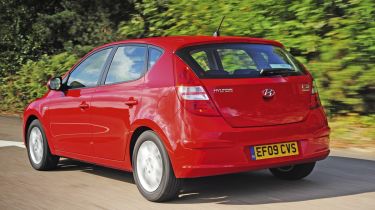Hyundai i30 Comfort
For a similar price to the budget Nemo you can get a capable, full-sized family hatch. So does the Hyundai really make more sense?
In its final encounter, the Nemo faces up to arguably its toughest rival: the Hyundai i30. At this price you might think a normal family hatchback is out of reach, but the impressive Korean car is competitively priced.
Take a look at the firm’s line-up and you’ll see that the entry-level Comfort model costs only £11,600. While that is a £605 premium over the Citroen, this extra outlay buys you a lot more standard kit, Hyundai’s trademark five-year warranty and the promise of grown-up driving dynamics.
You also get surprisingly classy looks. The i30 could easily be mistaken for a model which costs a great deal more. While it can’t quite match the bold styling of the Nemo, it’s handsome and understated.
It’s an entirely conventional design, yet neat details such as the tall rear light clusters boost its visual appeal. The car shown in our pictures is the special-edition ES, although even entry-level models get alloys, along with body-coloured mirrors and bumpers. Against the tape measure the Hyundai is much longer and wider than the Nemo, which should mean more cabin space. But in reality the two are evenly matched. In fact, the Citroen feels roomier, while its numerous storage cubbies make it more versatile.
However, the French car trails its rival in the quality stakes. Soft-touch plastics are used throughout i30’s cabin, while the solid build means no squeaks or rattles on the move. Up front, there’s a smartly styled dash with dials that feature blue backlighting, which helps to create a premium feel at night.
The interior is packed with kit, too. Air-conditioning, an iPod connection and steering wheel-mounted stereo controls are all standard. The Citroen has none of these items, and even features basic pop-out rear windows. Simply specifying air-con – vital in a car with so much glass – will put the Citroen within £100 of its Korean rival. The Nemo does provide more luggage space, though. Its 360-litre boot has a 20-litre advantage over the Hyundai. And with the seats removed, its maximum carrying capacity of 2,500 litres is impressive. However, the trade-off for its van-like load area is obvious on the road.
Turn into a fast corner and the high-sided Nemo displays extreme body roll compared to the i30. Its slightly gruff 1.4-litre diesel powerplant always makes its presence felt and its gearbox has a sloppy, imprecise shift action. Take a drive in the Hyundai and the contrast is stark.
At idle the i30’s 1.4-litre petrol powerplant is virtually silent, and it remains refined throughout the rev range. The Korean car is quick, too, thanks to a healthy power output of 108bhp. At the test track, the i30 took only 11.3 seconds to sprint from 0-60mph, leaving the Citroen trailing by a huge margin of 6.8 seconds.
But it’s the Hyundai’s composed chassis which really impresses. Although it’s no hot hatch, it feels safe and secure through corners, plus its steering is well weighted and direct.
The pleasingly judged suspension soaks up the worst of the bumps, but the car lacks the low-speed comfort of the softly sprung Citroen. For family buyers it will be the i30’s standard-fit electronic stability control that raises eyebrows, as this valuable safety feature is simply not available on the Nemo, even as an option.
There’s no denying that the Citroen has charm, versatility and price on its side, though. And it should also be cheap to run thanks to CO2 emissions of 119g/km. A low insurance group rating and respectable fuel returns of 36.1mpg from its diesel engine also make it the more wallet-friendly choice – the Hyundai managed a disappointing 30mpg.
Yet this black mark fails to spoil the achievements of the talented i30. If you can live without the Nemo’s extra boot space, the Korean car’s more grown-up feel and all-round ability win the day.







